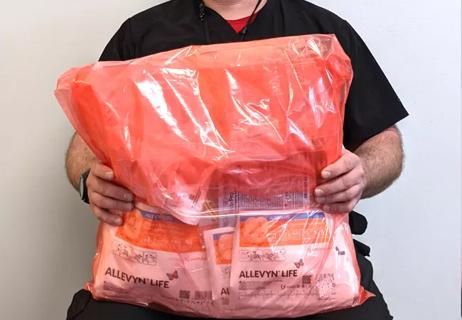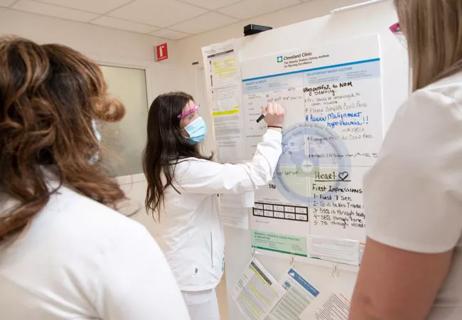Advertisement
A Q&A with Karen Schaedlich, MSN, RN, Innovation Program Coordinator

The American Nurses Association stresses that “every nurse is an agent of change and an innovator.” Within the Zielony Nursing Institute at Cleveland Clinic, nurses are supported through the Ideas to Innovation (I2I) Program, which helps caregivers develop their ideas and, when applicable, move them to market through Cleveland Clinic Innovations (CCI), the healthcare organization’s commercialization arm.
Advertisement
Cleveland Clinic is a non-profit academic medical center. Advertising on our site helps support our mission. We do not endorse non-Cleveland Clinic products or services. Policy
From 2015 to 2019, the number of well-developed innovations submitted to CCI from the Nursing Institute quadrupled, with a 43% increase between 2018 and 2019 alone. In 2019, the Nursing Institute was No. 2 of all institutes for quantity of innovation disclosures to CCI. Although those numbers are impressive, Karen Schaedlich, MSN, RN, innovation coordinator in the Office of Nursing Research and Innovation within the Nursing Institute, firmly believes nurses at Cleveland Clinic – and elsewhere – are only beginning to tap into their potential as innovators. ConsultQD sat down with Schaedlich to discuss her vision of nursing innovation.
Q: Why are nurses uniquely positioned to conceive innovations and bring them to fruition?
A: Nurses are natural problem solvers and critical thinkers. We are often caregivers at the bedside. Our practice requires us to observe, analyze, evaluate next steps and make changes as needed to meet the needs of patients. There is a saying that on average, inpatient nurses have four work-arounds per shift. That tells you how often nurses are thinking of ways to make improvements, whether it’s tackling a small problem or a larger, ongoing issue. Many innovations are created after identifying needs from real-life experiences.
Nurses are also passionate and resilient. To advance an innovation, inventors need to be passionate about their idea and demonstrate determination and resilience in overcoming roadblocks. The time from an innovative idea being born until its final development can take years. Nurses often demonstrate these three qualities – passion, determination and resilience – because they ultimately know that their innovation will make a difference in the lives of the people their innovation is aimed at.
Advertisement
Q: Can you provide examples of the kinds of innovations you’ve seen from nurses that have ultimately been implemented into clinical practice?
A: At Cleveland Clinic, we have seen a wide breadth of innovations. Nurses have invented products, information technology solutions, algorithms, risk scores, assessment surveys and much more.
To show the diversity of innovations that come forward, some examples are: an assessment of nurses’ knowledge of self-care for patients with heart failure, information technology software in adults that provides automatic early warning of important hemodynamic changes that could trigger nursing actions and a risk assessment of fall risk in patients hospitalized with oncology diagnoses. Another example is a product that helps keep IV lines off the floor when hospitalized adult and pediatric patients are ambulating or when ICU pumps are placed outside the room door in isolation cases. In a final example, a disposable cooling vest was developed to keep surgeons cool in the operating room without a tether. Many of our nurses’ innovations are commercially available and nurse inventors can discuss use, outcomes and features. I could offer so many examples of nursing innovations!
Q: Do you have any tips for nurses to help them begin to think like innovators?
A: See what’s around you – the small problems or the large issues you want to solve – and start asking questions. Innovators have inquisitive minds. Ask yourself questions like, “What would the ideal scenario look like? What is missing from it now? How can I bridge the gap?” Don’t be afraid to think big with solutions that would disrupt the current scenario. At first, thinking big may make people feel uneasy because the change is so different than what currently “is”. But, you may be onto something big!
It is also important to know that not all ideas will move forward, and this is a normal part of innovating. True innovators come up with many ideas, knowing eventually they will find the one that proves successful and enjoy the journey along the way.
Q: What advice do you offer nurses who think they have a good idea, but don’t know where to start?
A: When you have an idea, first go to the Internet to see if it’s already out there. There’s nothing more frustrating than when you spend a lot of time on an idea, then realize it has already been developed and commercialized. Then, design your novel solution. Do a drawing if it’s applicable. We don’t expect elaborate drawings – we are nurses, not artists. A drawing forces you to further develop your idea.
Advertisement
I recommend that you talk to colleagues or those with a completely different background and perspective that you trust or that can offer expertise that you lack, such as an engineer, electrician, chemist or physician. They can help you consider options, advance your ideas or advance the novelty aspect of your innovation. Within Cleveland Clinic, anyone within the Nursing Institute can connect with our nursing innovation team – one-on-one or as part of a group to receive support.
Q: Do you have any parting thoughts?
A: Globally, it’s an exciting time for nurses who have been longing for someone to say, ‘Hey, what are your ideas?’ They are hungry for someone to listen and help guide them toward making their ideas a reality. Many nurses have already implemented awesome ideas on their units; sometimes it’s just a matter of recognizing the ideas as novel and disseminating their solutions internally and externally. I am so happy to serve as our innovation coordinator because I get to see the brilliant minds of nurses at work every day!
Advertisement
Advertisement

Clinicians embrace immersive technology to learn real-world skills

Transforming care delivery, improving outcomes

Nursing caregivers advocate for smoke-free surgeries

Nurse assistant’s innovation helps colleagues

An algorithm, expert team and research lead to upgrades

Design encourages focused sharing of information

Nurses create hand-off tool to decrease falls

Recommendations from ACNO Dr. Nancy Albert